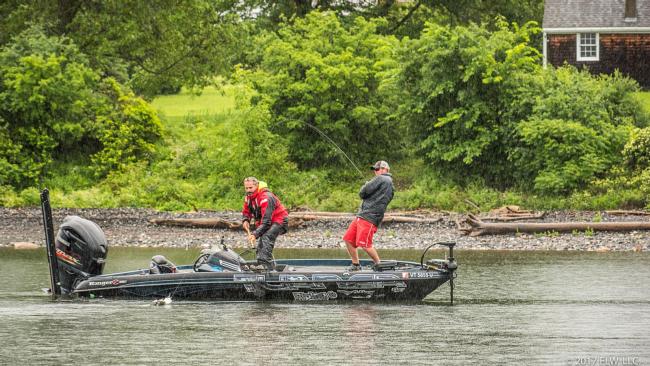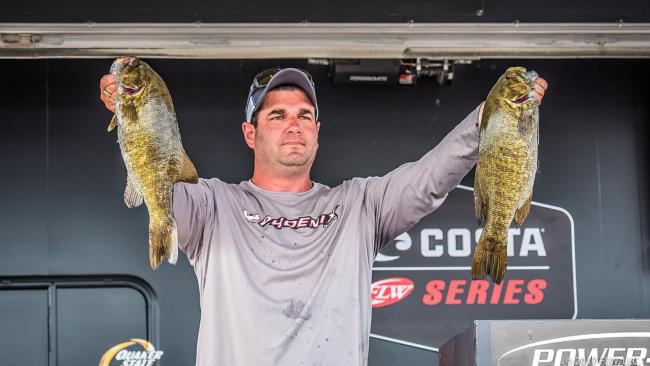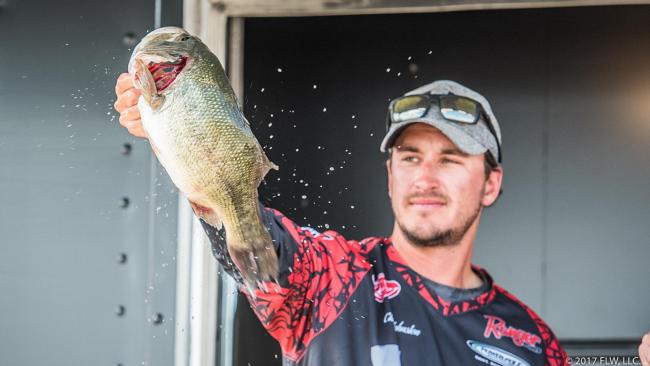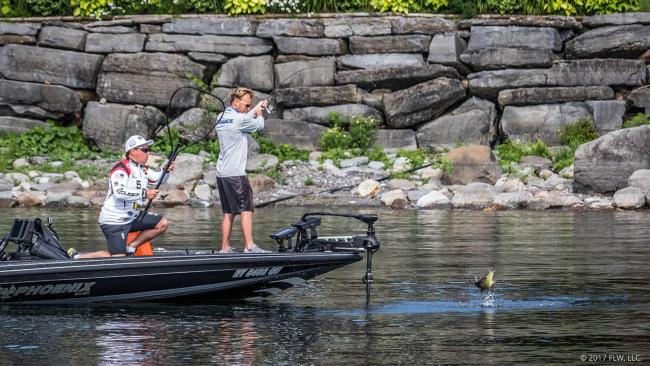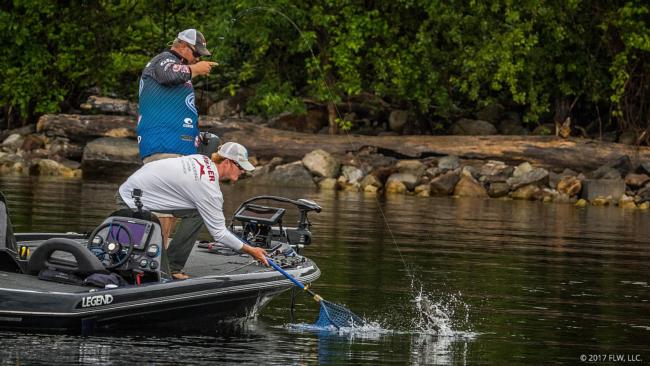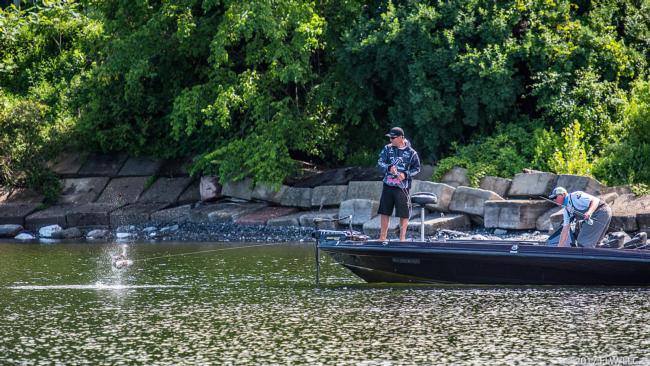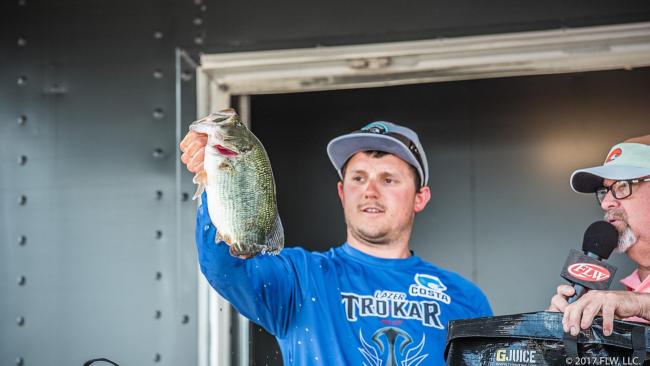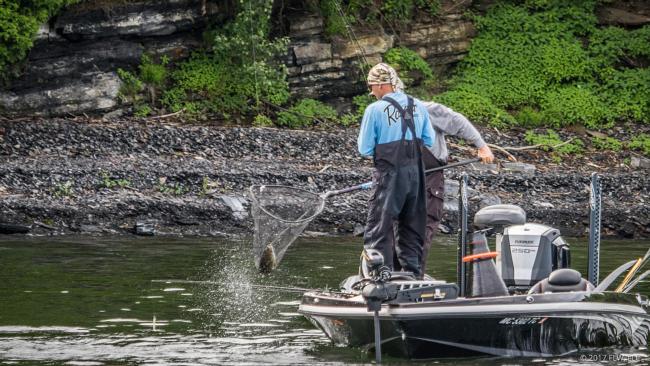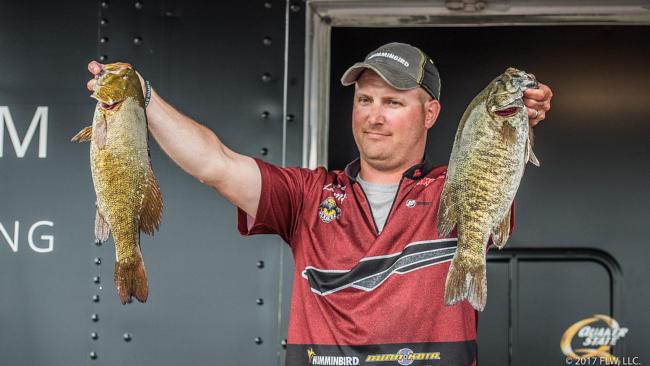Top 10 Patterns from Lake Champlain
The spawn was on
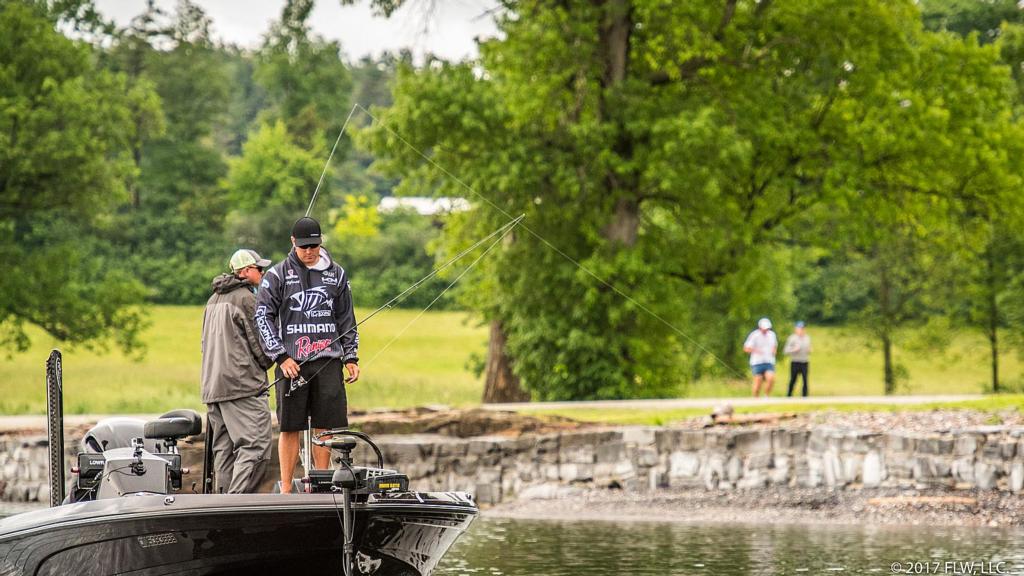
Prespawn and spawning smallmouths would win a lot more often on Lake Champlain if the catch-and-keep fishing season opened earlier in Vermont and New York. As it is, the tail end of the smallmouth spawn usually butts into the start of the tournament season, and smallmouths become key for only a short period of time. This year, due to a wet and cool spring, the big pond was running a little behind schedule when the Costa FLW Series event presented by Power-Pole got underway. As a result, the Northern Division opener featured bag after bag of spawning smallmouths. Though Ron Nelson needed to add in some largemouths for the win, the sheer number of 3-pound smalljaws that pros ran back to Plattsburgh was impressive.
None of the top 10 pros made the long run down to Ticonderoga to fish for largemouths, though a number did run quite far south into the main lake to fish for smallmouths. Last year, anglers in two major tournaments at Champlain predominantly fished up north, but some in the top 10 did still make the run to Ti. In 2015, Glenn Browne blew out the Costa FLW Series tournament on Champlain by flipping largemouths from the summer grass in Ti. It’s very unusual that Ti didn’t play this time, but not entirely surprising. The immediate postspawn is always a little sketchy down there, and that section of the lake has been a little “off” in recent years.
One final element that really came to light this tournament was how useful “floggers” can be for spawning smallmouths. The clear water in the north end of Champlain really facilitates their use, and though Costas can cut a lot of glare, there’s nothing like using a bathyscope underwater viewer to really see down into the water. Especially for looking at smallmouths spawning in 8-plus feet of water, the underwater viewers were critical for some pros in practice and on tournament day.
2. Adams goes all smallmouth
From Shrewsbury, Vt., Chris Adams has grown up chasing bass on Champlain. With checks in every Costa FLW Series event he’s fished on the big lake, he’s evidently got a pretty good handle on it. This year, he achieved his best finish yet and very nearly won the whole shooting match.
Adams came into the tournament with pages of notes, years of history and dozens of waypoints for spawning smallmouths.
“I still left one fish out there, but I wasn’t going to catch her,” says Adams. “I might have spent 45 minutes on her, and she was right about 4 pounds, and there was no chance. After that I went fishing and did my deal, and all except one of my bag were new fish.”
Adams fished the north end some and the main lake quite a bit, and didn’t have nearly as much pressure on his areas as some other top 10 finishers did.
“It sets up for how I like to look for them, and it gives you enough water that you have stuff to yourself,” Adams says of his areas. “I had a couple fish leave that I know just left, but I only had three or four that I know were caught by other anglers.”
Adams never looked particularly deep for smallmouths, and caught most of them in about 5 feet of water. On days one and two he caught mostly pre-marked fish, and fewer than 10 bass per day. On the final day he landed more than 30 bass to amass 16 pounds, 13 ounces of weight – his lightest bag of the week. He says he barely used a flogger the whole tournament, and relied more on his eyes and history than anything else. For baits, he says he used a swimbait, a drop-shot, a craw and a tube.
3. Lavictoire leans on smallmouths as well
Thomas Lavictoire Jr. also weighed all smallmouths each day for a total of 52-3. Like Adams, he was sight-fishing almost exclusively.
For the most part, Lavictoire fished south of Plattsburgh and didn’t have much company other than Scott Dobson on day one.
“I’ve got a lot of little sneaky deals that I do around here, and there’s only a few guys that fish around me other than a couple of clowns from Michigan,” says Lavictoire. “I kinda jumped around here and there. I don’t look at 3-pounders; you hope to not catch those. Generally you try and drive by those and look for those 3 1/4- or 3 1/2-pounders.”
Most years, Lavictoire can be found fishing for largemouths, but that wasn’t the case this year.
“I didn’t this time, only because I knew spawners would dominate,” says the Vermont pro. “Typically you can’t get away with sight-fishing three days; you have to mix it up at least on the third day. I really do believe fish are still coming. Typically one or two days you can do it, but this tournament is completely different. The whole lake is three weeks behind. They should be done. We should be bangin’ on largemouth right now, not catching spawning smallmouth that are still coming.”
Lavictoire and most of the other local experts attribute the long spawn to a cooler-than-usual spring.
“We never really got a lot of temperatures in the 80s and 90s,” he says. “You’ve got to remember that water is cold, and it takes sun to bring it [the water temp] up, and we didn’t get a whole lot of sun in April and May. It was a lot of cloudy and rainy days then. The water in the mid-lake is still around 59 or 60 degrees. There are fish that haven’t even thought about coming up.”
To tempt his smallmouths, Lavictoire says he used a swimbait, a Jackall Crosstail Shad on a drop-shot and a Zoom UV Speed Craw on a light Texas rig.
4. The Johnston train rolls on
Chris and Cory Johnston finished fourth and 18th, respectively, on Champlain after finishing third and 21st in the FLW Tour season finale at the Potomac. It’s not a shock, but it sure seems like the Canadian duo is set up to have a very profitable summer up north.
Chris did some sight-fishing for smallmouths and largemouths, but he also did a little “regular” fishing for largemouths each day. Essentially, he fished the winning pattern, but didn’t do quite as well as Ron Nelson did.
“I only had two and a half days of practice, which kinda hurt because it wasn’t the best weather for finding bedding fish,” says Chris. “I knew there were a bunch bedded, but I kept looking for largemouths as well because that’s normally how you get your big weights – you get 17 pounds of smallmouths, and then you get a kicker.”
The 2016 Tour Rookie of the Year says he came into day one with about 20 solid fish marked on beds, but no 4-poounders. On day one, he only caught three smallmouths off beds and filled out with largemouths. On day two, he burned most of the rest of his smallmouths to weigh five brown fish and make the cut.
Weighing a mix of species on the final day, Chris fished “anything shallow” for largemouths, flipping docks, bulrushes and grass north of Plattsburgh and in the Inland Sea.
The Canadian pro used a Jackall Crosstail Shad on a drop-shot for smallmouths and a Punisher Jig and a Yamamoto Senko for largemouths.
5. Carnright tries for largemouths
Fishing his first-ever Costa FLW Series tournament, Brett Carnright of Plattsburg, N.Y., weighed 52 pounds even on the week, and all but one of his weigh-in fish were bedding smallmouths.
He mostly fished north of Plattsburgh in the main lake for smallmouths, and primarily targeted slate banks. Carnright says he had more than 50 beds with 2 3/4-pound smallmouths marked going into the event, but only about 20 with 3-pounders marked. After he finished a limit with smallmouths, Carnright went fishing for largemouths each day, flipping some in Carry Bay, but mostly heading up to Missisquoi Bay.
“I was throwing a Senko on wood, in 2 to 7 feet of water,” says Carnright of his largemouth deal. “It’s something I’ve done before this time of year, and I caught them in practice. I figured if I was going to do well in this tournament I’d need to go up there and catch some of them.”
Carnright lost a big largemouth on days one and two. With them, he might well have contended for the win.
He fished a tube and a drop-shot with a Berkley PowerBait Pro Twitchtail Minnow for smallies and a weightless Yamamoto Senko on the wood for largemouths.
6. McFarlin falls on the final day
Shayne McFarlin led on days one and two, but only managed a little more than 15 pounds on the final day. That was enough to drop him down to sixth in the wicked-tight event.
McFarlin basically sight-fished for smallies the whole time, and spent most of his time in the main lake north of Plattsburgh on steep-ish slate banks as well as more gradual rocky shorelines. He says he targeted water in a certain temperature range, which dictated where he fished in the lake.
“I was looking for 62 to 63 degrees. Today [Saturday] it got up to 64.6 degrees,” says the Georgia angler. “I ran out of quality. They just got slim on me. We caught a lot of fish today, but I only found one that was the right size, and I couldn’t get it to bite.”
His key tools were a 3.5-inch Keitech Swing Impact (sight flash) on a drop-shot and a 3.8-inch Keitech Swing Impact FAT on a 3/8-ounce 2K Jigs Power Lock Ball Jig that was painted chartreuse.
More: McFarlin’s patterns on day one and day two
7. Farlow heads south
Neil Farlow weighed 58-1 on the week and turned his Ranger south out of Plattsburgh each day to hunt for spawning smallies.
Day one was quite windy, and Farlow actually fished some then, but he sight-fished the final two days in the calmer weather. Fishing from Burlington to Converse Bay, Farlow made his home on the Vermont side of the lake.
“The water temperature looked right, it was clean and I wanted to go for smallmouths,” says Farlow of his location decision. “I figured that was the area to go. I wanted 60 degrees, and it started 57 in practice and was up to the 60s today [Saturday]. I knew it had to be right.”
Farlow, from Niagara Falls, Ontario, was fishing Champlain for only the second time. His primary bait was a drop-shot with a Jackall Crosstail Shad. Farlow fished the event out of a Ranger with a deep-V hull, so he rode in comfort the whole time. However, the added height of the gunwales meant he never made use of a flogger like many of the other pros.
8. Last-day largemouths help Latinville
Another young Plattsburgh native, Ryan Latinville weighed all smallmouths the first two days and mixed in three largemouths on the final day.
For smallmouths, Latinville sight-fished anywhere from the Inland Sea to Rouses Point. For largemouths, he ran up toward Missisquoi Bay.
“I was targeting big offshore wood, fairly deep stuff, out in 8 and 9 feet that I had marked from the past,” relays Latinville. “You might be able to see the tip of it, but some of it you couldn’t see at all.”
Latinville and Carnright, who are cousins, worked together to prepare for the tournament, and it paid off well for both of them.
“We have a good deal,” says Latinville. “We both made the top 10. We practice together, we work together, we’ve got a pretty good system going on.”
Latinville says he sight-fished with a Gene Larew Punch Out Craw in white and Bama bug and also flipped it on the back of a jig.
9. Dobson starts the season strong
Scott Dobson is a terror when smallmouths are involved, but of his 45 top-10 finishes with FLW, this is his first on Champlain.
He sight-fished a lot, but also mixed in some postspawn fish in the Inland Sea on day two. For those, he fished a swimbait, spinnerbait, Lucky Craft Pointer 100 and DUO Realis Spinbait 90. For his spawning fish, Dobson ran south along the New York side on day one, and then fished north of Plattsburgh on day two.
Dobson targeted bedding fish in about 10 feet of water, marked perhaps 100 beds in practice and used a flogger to determine the size.
“It’s called a bathyscope; flogger is the fishing name,” says Dobson. “I put black duct tape around mine so the light doesn’t get in it, and you can see a little bit deeper. The fish will actually come up and check it out. Four times in the last week I had smallmouth come up and yank my rod into the water with the bait just tapping on the water.”
Dobson says he and practice partner Bryan Doyle had a pretty good system put together. Dobson ran the trolling motor and looked and Doyle got down with the flogger to check the size.
10. South again for LaMoy
Finishing 10th, Rob LaMoy continued the trend of heading south from Plattsburgh in search of cooler water and less-pressured fish.
“I watched the FLW Tour last year, and Scott Martin and David Dudley were fishing on two of my best stretches, so I knew it would get hammered. And Dudley was fishing [this event], so he would be on that spot again,” says LaMoy, who hails from Chazy, N.Y. “I like having stuff to myself, and we had a real calm day last week, so I took my daughter’s boyfriend and we ran down there. It was sunny and flat, and it was just ridiculous. I ended up seeing 65 fish by the end of the day, and it just got better from there. You follow the temperature. Down there it’s the largest mass of water in the lake, so it takes forever for it to warm up. I just followed them south into the colder water.”
LaMoy landed good bags on days one and two, but could only scratch up 14 pounds on the final day. To catch ’em, the local angler sight-fished with a 3-inch Keitech Swing Impact (sight flash) on a drop-shot and a 3.3-inch green pumpkin Keitech Swing Impact FAT on a 1/4-ounce jighead.
